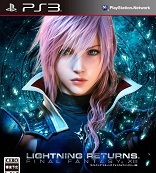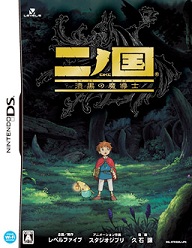Infinite Space
Nintendo DS
Reviewed: 5/11/2010
An empire of gargantuan might seeks to dominate every galaxy in existence. Space pirates fly about seemingly unchecked as the nations that would combat them struggle in political turmoil. An evil worse
than the gods uses its abilities to play with the lives of humanity. Zero G dogs – the privateers of the ocean of stars – do what they must both to survive and make fame for themselves. In the middle of it all, a young boy named Yuri decides to break free from the planet he has called home for far longer than he would wish. Quickly the darkness of space, as well as its intrigue, wholly
envelop him.
Welcome to the world of Infinite Space.
Let’s not mince words here: this game has a learning curve that is not user friendly. Information about what types of ships are which and how to do everything are thrown at the player with the volicity of a
Corsair class ship. Then there’s about an hour of gameplay in which half of these skills aren’t even used, followed by a battle in which almost all of them are. Indeed, the first three hours of this game are some of the most difficult to overcome.
Nobody said flying in space would be easy.
The battle system, as clunky as it first feels, is unique and refreshing. There are two gauges the player will pay attention to. The first is an energy bar that raises from red to green and holds up
to four charges. This bar directly influences what abilities the player can use. The rate it rises is pulled from such things as how livable the ships in one’s fleet are as well as how rested the crews
are. The second gauge shows how close one’s fleet is to the enemy fleet, and affects which weapons can be used based off of how the ships are equipped. As a backdrop of these two bars, the player can see the control room of their flagship and can watch as the captain issues out orders and the characters in charge of specific areas react. This works exceptionally well both because of the feel it gives the combat and because when a player is grinding they can simply skip over it.
Initially, there are only three commands in a player’s repertoire.
They can attack with a normal volley of shots. They can barrage, which takes less energy to do but requires a gauge that is at least three-fourths full. Finally, they can dodge, which will make incoming barrages near useless at the cost of ensuring normal attacks always hit. Later in the game, other commands are opened to allow for the use and defense of fighter ships, to make use of the special abilities of certain spacecraft. Certain recruitable characters can also give special attacks for ships.
Most of the customization in this game comes from equipping modules to ships. Module blueprints are bought, and from then on unlocked for any ship the player may have. Modules can do anything from increase livability to the amount of experience a certain type of crewmember might get to. Different ships have different module boards in which modules can be placed, and the size and shape of modules need to be kept in mind as the player does so.
The graphics are best described as “functional.” Character profiles look like something that stepped out of Heavy Metal comics, which is certainly a grittier look than might be found in most JRPG flair but the style works perfectly here. The spacecraft all have unique looks, but they aren’t customizable and some of the color choices are laughable and damned if they aren’t blockier than Grus. The overworld
map is exactly that: a map. A lot of visited places, like the tavern, have one of two images and the player will be seeing these images a LOT.
There is a feeling that something went wrong with the sound encoding, as all of the music has this tininess to it that become very grating after a while. That said, the music fits the game and the theme quite well and with only a few The voiceovers were done by Webtone, who is best known for its corporate answering machine messages. Perhaps this company should consider doing more voice work for other games, because they got the voices for Infinite Space dead on. Be it the voice of Nina in one of the rare cutscenes this game has, or the random voices that can be heard in battle, the
voices hit this game spot on.
In the second half, Yuri and his rag-tag crew go forward to save the entire human race, despite the fact that clearly some of humankind doesn’t want to be saved. Lots of people will die, a teenage boy in a dress
will almost get raped, themes of incest will be explored, and holy hell, there’s a lot of people that have names that die in this game. This reviewer’s personal favorite part is when, in order to extract information from a pirate, Yuri cuts off both arms of that pirate. Schwing schwing, now quitcher bitchin’ and speak up, evil pirate overlord. Good times there.
The game is epic in length, easily taking between 60 and 80 hours to beat. However, it is far from being flawless. It is easy to forget where one needs to go because there is no in-game quest log. Further aggravating this is the fact that sometimes the trigger for a quest is an obscure bit of chatter in a tavern one might have already checked, but needed to be checked twice. The difficulty of even random battles can be so frustrating that throwing the Nintendo DS across the house in violent rage seems like a good thing.
Something should be said about melee battles, which are these rock-paper-scissor games of madness that the game forces the player to deal with; they look something out of an Atari 7800 game and the computer is always better than the player because it chooses its moves based on the player. The interface of the game is about as counter-intuitive as it could have possibly been while still being learnable.
This game will definitely be polarizing. After the four hour mark, there will be those that absolutely desire to put this game down in frustration as its ridiculous learning curve overwhelms them. There
will also be those who find this game to be exactly what they’re looking for as they navigate the stars. One thing cannot be argued, however: Infinite Space has a well executed story with a science fiction feel that has yet to be matched on the Nintendo DS.
-Tim Olsen
| Score Breakdown | ||
| Overall Great Out of 10 See our Review Criteria |
Gameplay | Average |
| Story | Legendary | |
| Graphics | Average | |
| Sound/Music | Great | |
| Replay Value | Great | |
| The Verdict: Great | ||








